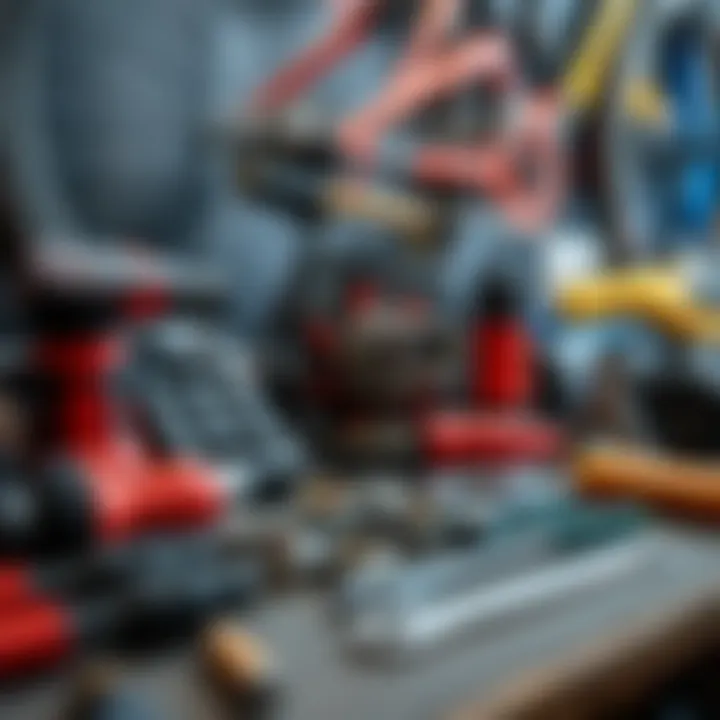Mountain Bike Drive Train: Components and Innovations


Intro
Mountain biking is more than just a sport; it’s a thrilling pursuit that combines endurance, skill, and a bit of daredevil flair. Behind every impressive descent or challenging climb lies a complex system: the drive train. Understanding the mechanics of this system not only enhances performance but also influences the overall riding experience. As with the heartbeat of a bike, the drive train plays a vital role in how efficiently power is transferred from the rider to the wheels.
In this guide, we will delve deeply into the components of mountain bike drive trains, exploring innovations that have transformed how we ride. From various gear systems and their functionalities to the importance of maintenance and compatibility, we aim to equip thrill-seekers and adventure lovers with the knowledge they need to make informed decisions. Whether you’re a weekend warrior or a competitive racer, grasping these concepts will elevate your biking experience.
"A well-maintained drive train is the unsung hero of a mountain cyclist's success."
As we navigate through the intricate layers of the mountain bike drive train, you’ll discover tips to hone your riding skills, ways to choose the right equipment, and key practices to ensure safety. Buckle up as we take on this exciting ride through mechanics and innovations!
Foreword to Drive Train Mechanics
Understanding the mechanics of a mountain bike drive train is fundamental for both performance and rider experience. The drive train acts as the heart of the bike, translating the energy generated by the rider into effective propulsion. Grasping how it works can unlock a new level of appreciation for mountain biking, transforming the way enthusiasts interact with their gear and the trails. In this section, we will dive into the key aspects of the drive train, shedding light on its components and their functions, and illustrating why a finely-tuned system enhances not just speed, but also handling and efficiency.
Understanding the Drive Train's Role
At its core, the drive train consists of various components working in unison. The most recognizable of these are the chain, sprockets, and derailleurs. However, it is essential to think of these parts as part of a larger ecosystem, where each has its vital role. The chain, for instance, transmits power from the pedals to the rear wheel. Any inefficiency in this transmission can lead to slippage or loss of power, which is the last thing any rider wants when tackling a steep climb.
Moreover, the drive train also plays into the bike’s overall geometry and weight distribution. A well-optimized system not only ensures smooth gear transitions but also keeps the bike agile over rocky terrains. Proper understanding of how each component interacts allows riders to make informed decisions about upgrades and maintenance, leading to better performance on the trails.
Importance in Mountain Biking
In mountain biking, where terrain and conditions can change in the blink of an eye, the drive train becomes even more critical. It’s not just about getting from point A to point B; it’s about conquering every twist and turn with precision. Here are some reasons why the drive train matters:
- Efficiency: A well-maintained drive train ensures that the energy expended by the rider translates effectively into forward momentum.
- Adaptability: Different trails require different gearing; understanding how to manipulate the drive train enables riders to adapt swiftly.
- Durability: Maintaining a drive train prevents unexpected breakdowns that can ruin a day out on the trails. Regular checks and balances directly contribute to the longevity of these critical components.
- Performance Enhancement: Upgrading individual components can lead to significant improvements, whether it be through better gearing systems or lighter chain materials that aid in climbing.
"A finely-tuned drive train can mean the difference between conquering a climb and having to push your bike uphill."
In summary, a mountain biker's relationship with their drive train shapes their entire riding experience. Understanding its importance, mechanics, and maintenance sets the stage for taking full advantage of the exhilarating world of mountain biking.
Key Components of the Drive Train
The drive train of a mountain bike acts as the backbone for performance and efficiency. It encompasses a range of components each working in harmony to optimize the rider's experience while tackling varying terrains. Understanding these key components allows riders to make informed choices when selecting or maintaining their bike, ensuring each adventure unfolds without a hitch. Here, we will break down three fundamental elements of the drive train: the chain, sprockets and gears, and derailleurs.
Chain
Types of Chain
When diving into mountain bike chains, one quickly realizes that not all chains are created equal. Standard chains, like those found in single-speed setups, are robust and simple, perfect for minimalists who seek efficiency without the hassles of complex gearing. On the flip side, multi-speed chains come with their intricacies. Their link plates often feature thinner profiles to reduce weight, making them ideal for competitive races or rugged trails.
One of the standout characteristics of the multi-speed chain is its ability to handle varying gear ratios smoothly, which enhances the riding experience. However, the thinner design might lead to quicker wear, demanding more frequent inspections and potential replacements compared to their single-speed counterparts.
Material Considerations
The material used in chains is crucial for performance in mountain biking. Many riders prefer stainless steel chains for their durability, as they resist rust and corrosion—key factors for those who've ever encountered rain-soaked trails. However, some may opt for aluminum alloys that are lighter yet boast a shorter lifespan.
A unique aspect of modern chains is their treatment with various coatings. For instance, chains with nickel-plating offer a balance of reduced friction while increasing longevity. Yet, this often comes at a higher price point, which can be a barrier for beginner riders or those on a tight budget.
Wear and Replacement
Regular wear and tear is an unavoidable part of biking. Over time, chains elongate and become less efficient, which can lead to skipped gears and inefficient pedaling. A crucial aspect of wear and replacement is understanding how and when to check a chain's condition. Riders should consider using a chain checker tool, which measures the elongation and informs whether it’s time for a swap.
Prompt replacement is beneficial; it not just ensures smooth shifting but also protects other components like sprockets and derailleurs from undue strain. A worn chain can create a cascade of damage, costing more in the long run.
Sprockets and Gears
Gear Ratios Explained
The concept of gear ratios can seem daunting, but it's essential for handling different inclines and surfaces when mountain biking. In simple terms, the gear ratio is the relationship between the number of teeth on the front sprockets and the rear sprockets. A higher gear ratio allows for more speed on flat surfaces, while a lower gear ratio is typically employed for climbing steep hills. This adaptability is beneficial as it lets riders find a rhythm that suits their style, whether they are gunning for an adrenaline rush or striving for endurance on epic voyages.
One unique feature of these ratios is their capacity to influence cadence. Adjusting to the right gear ratio can help maintain an optimal pedaling rhythm, which improves fatigue management during long rides. However, choosing the right ratio can mean the difference between flying down a hill and spinning your wheels uphill, illustrating the nuanced relationship between rider choice and gear setup.
Pace and Terrain Adaptation
When it comes to mountain biking, pace and terrain are intertwined. Some trails demand quick bursts of speed while others may require steady climbs. The relationship between gear choice and terrain is paramount; riders must constantly adapt their gear based on the terrain’s challenges.
For instance, a switch to lower gears can help conquer steep forest trails or rocky paths, while higher gears can blast down smooth, flowing descents. This isn’t just about speed; it’s also about maintaining control and comfort during rides. The right gear choice can keep momentum going without breaking a sweat too early.
Derailleurs
Front Derailleur Functions
The front derailleur serves an important function in the overall bike performance. Positioned near the crankset, its primary duty is to shift the chain between the different front sprockets. This component allows a seamless transition between gears, which is crucial when changing the riding demands quickly, such as going from downhill speeds to uphill climbs.
A unique feature of the front derailleur is its alignment. It needs to be adjusted precisely to ensure smooth shifts without chain drops. This requires some trial and error at times, but once mastered, it's a smooth experience that can make tough climbs or fiery descents much more manageable.


Rear Derailleur Functions
Similar to the front version, the rear derailleur plays a pivotal role in shifting between different sized sprockets at the back wheel. It's often more complex, as it manages the chain tension through its spring-loaded design, ensuring smooth shifts even under pressure. This function becomes vital during rugged rides where rapid shifts may be necessary when trails get unpredictable.
What stands out with rear derailleurs is their compatibility with various gear ratios and their ability to maintain chain tension on diverse terrains. However, the complexity also brings the challenge of maintenance—keeping it clean and adjusting it properly ensures optimal performance. Riders sometimes overlook this aspect, which can lead to less efficient rides.
Understanding the intricacies of the drive train is crucial for anyone looking to truly engage with their mountain biking experience. Each component plays a vital role in performance, so recognizing how they work together can enhance overall riding satisfaction.
Types of Mountain Bike Drive Trains
Understanding the different types of mountain bike drive trains is fundamental, as they significantly affect the riding experience. Each type caters to various riding styles and terrains, ensuring that cyclists can find the right setup for their needs. The drive train's configuration influences not only the efficiency of power transfer but also the overall weight and maintenance requirements of the bike. Hence, this section illuminates the distinctive features and considerations of single-speed, multi-speed, and internal gear hub drive trains.
Single Speed Drivetrains
Advantages
One of the most appealing features of single-speed drivetrains is their simplicity. Without the complexity of gears, riders can enjoy a lightweight setup that offers reliable performance. This characteristic makes single-speed options especially advantageous for beginner cyclists or those who prefer easier maintenance. Another notable aspect is efficiency; with fewer components, there's less energy loss between the rider and the road. This translates to a direct power transfer that seasoned riders often appreciate. However, it comes with the trade-off of limited gearing options, which may pose challenges in hilly terrains.
Key characteristics include the reduction in mechanical failure points. Fewer parts mean fewer things to go wrong, making it a solid choice for riders looking for dependability without the fuss. Despite its limitations, a single-speed system can excel, especially in urban settings, where flat routes make the lack of gear options less of an issue.
Ideal Use Cases
Single-speed drivetrains shine best in specific scenarios. They are particularly well-suited for commuting or casual rides on flat terrain. Riders who primarily navigate city streets will find them efficient and quick, as these bikes are also lighter, enhancing manageability. Farms and bike trails with minimal elevation changes are ideal for such systems. However, planning rides requires a bit of foresight since the rider's fitness level and terrain must be compatible. Among mountain bikers, those who relish straightforward rides often opt for single speeds, valuing ease of use over rapid gear changes.
Multi-Speed Drivetrains
Technological Overview
Multi-speed drivetrains epitomize versatility, allowing riders to adapt their pedaling with the terrain. These systems offer a wider gearing range, empowering cyclists to handle both uphill climbs and swift descents effectively. The advancements in gear technology over the years have paved the way for more reliable shifting mechanisms. Such innovative mechanisms ensure smooth transitions across various cogs and provide a greater feeling of control. Each shift engages a different combination of gears, allowing cyclists to find the perfect combination for their rhythm and the land beneath them.
When building or upgrading a bike, many opt for a multi-speed drivetrain for exactly these reasons. This flexibility makes it a staple for mountain bikers who might face varying elevations and road conditions during a ride. However, as compelling as it is, prospective buyers should consider the potential trade-off in weight and maintenance compared to single-speed options.
Shifting Mechanisms
Shifting mechanisms are at the heart of the multi-speed drivetrain's functionality. These mechanisms, whether manual or electronic, dictate how easily a rider can switch between gears. There are two primary types: trigger shifters and twist shifters, each with its own feel and responsiveness.
A key characteristic of modern shifting systems is precision. High-quality derailleurs work in tandem with the gears to make transitions smooth and efficient. In technical terrain or when biking downhill, being able to shift gears quickly can make a notable difference in performance. However, it is essential to remember that added complexity in design can lead to increased maintenance challenges. Regular checks and occasional adjustments ensure that these systems function optimally for peak performance.
Internal Gear Hubs
Advantages and Disadvantages
Internal gear hubs offer a different approach entirely, with gears housed within the rear hub. This design provides a clean and protected mechanism, ideal for riders who prioritize minimal maintenance and longevity. One of the most significant advantages is the ability to shift gears while stationary—an appealing feature for many cyclists navigating urban landscapes or crowded trails. Additionally, since the gears are sealed, they are less susceptible to dirt and grime, which helps maintain performance over time.
On the flip side, internal gear hubs often come with a weight penalty and may not offer as wide a range of gearing as external setups. This trade-off is something mountain bikers need to consider. Those looking for high performance in steep climbs might find internal hubs limiting, yet they could appreciate the durability and reduced maintenance.
Maintenance Needs
The maintenance of internal gear hubs is generally convenient due to their sheltered nature. Cleaning and lubrication involve less frequent intervention compared to external gear systems. However, that doesn’t mean they are maintenance-free. Regular inspections are still vital to ensure smooth operation and to identify any potential issues before they become problematic.
For cyclists who wish to ride without the worry of constantly dealing with gear-related problems, internal gear hubs can provide peace of mind. They serve well for riders who may not be as mechanical or those who prefer to steer clear of potential complications associated with other drivetrain types. Nonetheless, understanding their maintenance needs is crucial for maintaining optimal performance.
Material and Engineering Advances
In the realm of mountain biking, the drive train is not just a collection of parts; it’s the heartbeat of a bike’s performance. As advancements in material science and engineering continue to evolve, mountain bike drive trains are becoming more responsive, efficient, and robust. This evolution is critical. Innovations in materials and technology have a direct bearing on a rider's experience, shaping everything from weight and durability to overall performance under diverse conditions. This section will explore how these innovations impact the future of trail riding, giving riders a competitive edge wherever they choose to ride.
Innovations in Chain Materials
The chain is arguably the most crucial part of a mountain bike drive train. Traditionally made from steel, modern chains have undergone significant transformations. Manufacturers now utilize alloys, high-strength steel, and even advanced synthetic materials that boast enhanced strength-to-weight ratios. For instance, companies like KMC have been experimenting with carbon-coated chains that reduce friction and improve efficiency.
The benefits of these innovations are manifold:
- Lightweight: New materials often mean lighter chains, which can decrease overall bike weight, leading to better maneuverability and less fatigue on long rides.
- Higher Strength: Advances in metallurgy allow for chains that can withstand greater forces, minimizing the chance of breakage during extreme riding.
- Resistance to Wear: Improved coatings and materials extend the lifespan of chains, reducing the frequency of replacements and ultimately saving costs in the long run.
These chain advancements align closely with the needs of riders who require reliable performance in rugged terrains while maintaining speed and efficiency.
Durability and Weight Reduction Techniques


As mountain biking demands often clash with durability, engineers have sought ways to enhance these attributes without compromising performance. A vital piece of this puzzle is weight reduction. The trend has been towards using lighter alloys and magnesium components, which present a significant reduction in weight, giving riders an edge in climbs without sacrificing strength. For example, manufacturers like Shimano have developed components that combine aluminum with carbon fiber, achieving the balance needed for high-performance riding.
Key techniques utilized in achieving these improvements include:
- Butting Techniques: Tubes or components are made with varying wall thicknesses, making them lighter while maintaining strength where it’s needed most.
- Advanced Coatings: Strategic coatings are applied to reduce friction and increase resistance to wear, extending the life of gears and other components.
- Modular Component Design: Manufacturers are creating parts that can easily be swapped out or upgraded, allowing riders to fine-tune their gear for specific trails or conditions.
These innovations help ensure that mountain bikers can enjoy a blend of speed and durability, essential for both competitive racing and recreational riding.
Integration with Electric Assist Technology
As electric mountain bikes (eMTBs) take the cycling world by storm, the drive train must also adapt. Integrating electric assist technology with traditional mechanical systems presents an exciting frontier in mountain biking. The synergy between pedal power and electric assistance brings new life to the riding experience across diverse landscapes.
Technological advancements in this area include:
- Smart Derailleurs: Enhanced derailleurs equipped with sensors that adjust gear shifts based on the terrain, ensuring smooth transitions and optimal power delivery.
- Battery Efficiency: New battery technologies are being designed to be lighter and more powerful, offering longer rides with less effort. The smarter use of electric power can make even the steepest of climbs manageable.
- Sync Technology: Innovations that allow the electric assist to work harmoniously with traditional mechanical systems provide smoother and more intuitive riding experiences.
Incorporating electric assist while maintaining a lightweight and durable drive train enhances the overall mountain biking experience, appealing to both seasoned and novice riders alike.
"The blend of electric power with traditional biking mechanics is like adding turbo to a race car; it redefines user experience and opens up new possibilities for where we can ride."
In closing, advancements in materials and engineering are fundamentally transforming mountain bike drive trains. As riders increasingly push the limits of what’s possible on trails, the role of these innovations cannot be underestimated. They are shaping the future of mountain biking, making it essential for riders to stay informed on these developments to fully harness their potential and elevate their cycling adventures.
Bicycle Gear Selection Strategies
Selecting the right gear for mountain biking is akin to finding the perfect dance partner; harmony between rider, terrain, and the bike can make all the difference in performance and enjoyment. A well-thought-out gear strategy can make climbs less daunting and descents more exhilarating. In this section, we delve into critical aspects that inform these selections, ensuring that riders can navigate diverse trails effectively.
Understanding Terrain and Performance Needs
Terrain shapes the biking experience like clay in a sculptor's hands. Each trail, with its unique undulations, obstacles, and surface types, demands a specific gear approach. Factors like steep climbs, rocky descents, or muddy stretches require different gear ratios and setups. Riders need to assess their environment, considering the following elements:
- Incline and Decline: Steeper inclines may warrant lower gears to maintain an optimal cadence, allowing riders to exert less force and conserve energy. Conversely, descending trails often exploit higher gears for speed and control.
- Trail Surface: The roughness of the terrain can dictate tread patterns as well as gear choice. Smooth paths might allow for higher speeds whereas loose gravel or mud can necessitate a more cautious approach with gears that provide better traction.
- Rider Skill Level: Beginner riders might prefer a wider range of gears to accommodate varied skill levels, while seasoned riders often feel comfortable with narrower gear ranges, capitalizing on their ability to shift quickly and efficiently.
Understanding these terrains ensures that bikers equip themselves adequately. This knowledge translates into a much smoother ride where riders can focus on navigating challenges rather than worrying about mechanical limitations.
Choosing the Right Gear System
Navigating the myriad of gear options can seem like picking a needle out of a haystack. It's essential to consider the compatibility of the gear system with both the rider's style and the expected riding conditions. Key considerations include:
- Single Speed vs. Multi-Speed: Single-speed setups are simpler, lighter, and less prone to mechanical failures, making them excellent for flat or predictable trails. However, they lack the adaptive qualities needed for varied terrains. Multi-speed systems offer versatility, allowing riders to adjust to changing conditions seamlessly.
- Internal Gear Hubs vs. External Gears: Internal gear hubs provide a reliable, low-maintenance solution, enabling shifts while stationary and influencing overall clean design. On the flip side, external gears are generally lighter and offer finer tuning for more aggressive riding styles.
- Gear Ratios: Optimal gear selection revolves around understanding ratios. Gear ratios impact acceleration and total speed; thus, it’s imperative to choose ratios that align with the rider’s desired outcomes.
The chosen gear system should resonate with the rider's instincts, allowing them to exploit their strengths against the ridge—much like a craftsman perfectly matching tools to their trade.
Impact of Rider Preference on Gear Choice
At the end of the day, what truly steers gear selection is the rider's personal philosophy regarding their biking experience. That subjective element can be crucial. Some riders thrive on precision, while others favor simplicity. Here’s how various factors of preference can play into gear choice:
- Comfort vs. Efficiency: Some riders might prioritize a comfortable ride, opting for lower gears that can feel less jarring on the body. Others may hunt for speed, seeking out the stiffest setups to maximize performance.
- Cycling Style: Downhill enthusiasts might embrace wider gear ranges for varying speeds, choosing systems that enhance control and adaptability. Trail riders often lean toward something slightly more balanced, favoring versatility to cater to unpredictable rides.
- Personal Experience: Familiarity with a particular brand or type of gear can overshadow technical specifications. Emotional connections and personal success stories with specific gear often steer choices as much as the mechanical details.
In the end, every rider's journey is unique, and so should be their gear selections. Understanding how personal preferences mesh with functional needs opens the door to a more fulfilling and exhilarating riding experience.
"Finding the right gear is like finding your comfort zone while embracing challenges; it's not just about the bike, it's about bonding with the ride."
In this section, we've taken a look at how terrain influences gear selection, what to consider when picking a gear system, and how rider preferences blend into this equation. By equipping themselves with the right knowledge, mountain bikers can maximize their joy and performance on the trail.
Maintenance Practices for Optimal Performance
Maintaining a mountain bike's drive train is crucial for ensuring optimal performance on rugged terrains. The complexity of a bike’s mechanical systems, especially the drive train, calls for regular upkeep to prevent unexpected breakdowns and boost efficiency. When the drive train components, such as chains, gears, and derailleurs, are well cared for, they operate smoothly together, enhancing the rider’s experience on challenging trails.
Regular maintenance not only extends the life of these components but also helps in preserving the bike's overall performance. Riders are often caught up in the thrill of the ride, but overlooking maintenance practices can lead to issues down the line.
Regular Inspections and Adjustments
Regular inspections of the drive train involve a closer look at all connected parts. Checking for wear and tear is vital. For instance, a chain that shows visible signs of stretching will definitely affect the shifting performance and power transfer in a negative way.


- Chain Wear: A worn chain should be replaced promptly to prevent wear on cogs and derailleurs.
- Sprocket Condition: Inspect the sprockets for any signs of bending or uneven wear. If you notice that teeth are breaking off or are excessively worn down, it might be time for a replacement.
- Derailleur Alignment: Misalignment can lead to poor shifting performance, and addressing this issue can save you both time and money in the long run. Adjusting the limit screws might be necessary to bring everything back in line.
It's recommended that these inspections are done every few rides, especially if you're hitting rugged trails regularly.
Cleaning and Lubrication Tips
Cleaning and lubrication are the bread and butter of maintaining your drive train. A clean chain not only enhances performance but also reduces wear on your components. Grime and dirt can act like sandpaper, wearing down the surfaces of the chain and sprockets. Here are some effective tips:
- Use the Right Cleaning Products: Specialized chain cleaners are designed to cut through grime without damaging the lubrication still present on your chain.
- Frequent Lubrication: After cleaning, ensure you re-lubricate your chain properly. Use a quality bike-specific lubricant, applying it to the inner surfaces of the chain links.
- Avoid Over-Lubing: While it might seem counterintuitive, too much lubricant attracts more dirt. Wipe off any excess after application.
- Check Your Gear Ratios: Different riding conditions may require adjustments in lubrication frequency. Muddy trails, for instance, necessitate more frequent cleaning sessions.
Avoiding Common Pitfalls
Mountain bikers should be cautious to dodge common missteps that can lead to poor drive train performance. One common pitfall is ignoring unusual noises; if a bike starts to make grinding or resonant sounds, it's usually a sign something needs addressing.
- Daily Checks: Incorporate brief inspections into your riding routine. A little attention daily can prevent significant issues over time.
- Ignoring the Chain's Sound: If your chain sounds dry or gritty, give it a clean and reapply lubricant.
- Neglecting to Monitor Changes in Performance: Any change in shifting quality should prompt a deeper inspection of your drive train components. Being proactive here can save a lot of hassle later, especially before significant rides or races.
"In mountain biking, as in life, it’s not just about the destination; it's about the journey and keeping the mechanics of that journey smooth."
In summary, regular maintenance practices are indispensable for peak drive train performance. They not only keep your bike functioning optimally but also enrich your overall riding experience.
Future Trends in Mountain Bike Drivetrains
The realm of mountain biking never stops evolving, and the drive train is no exception. Understanding the future trends in mountain bike drivetrains isn't just for tech enthusiasts; it’s crucial for anyone looking to enhance their riding experience. These advancements are about more than just keeping up with the pack. They focus on efficiency, performance, and ultimately contribute to the joy of riding in the great outdoors.
Emerging Technologies
A surge of innovations is altering how ride trains function. One of the hot topics currently making waves involves smart technology integration. Imagine a gear system that adjusts automatically, taking into account factors like incline, rider weight, and speed. This not only optimizes performance but also takes a load off the rider’s mind, allowing them to focus more on the trail ahead.
- Wireless Systems: Utilizing Bluetooth technology to communicate between components gives riders better control and maintenance options. Riders can diagnose issues through a smartphone app, avoiding those dreaded roadside repairs.
- Gear Ratio Adjustments: There's also talk of gear systems that adapt in real-time. This would provide a seamless shift whether climbing steep hills or speeding down trails, while also minimizing wear on components.
The focus of these innovations revolves around enhanced user experience alongside increased durability and efficiency on diverse terrains. With the rapid development, one might expect to see these technologies becoming mainstream sooner rather than later.
Environmental Considerations
As mountain biking gains popularity, being mindful of the environment has taken center stage. The industry's movements towards sustainability are becoming a pivotal aspect of future designs.
- Eco-friendly Materials: Manufacturers are searching for components made from recycled materials, reducing the environmental footprint. For example, chains made from repurposed metals could spread, lessening the reliance on virgin resources.
- Energy-efficient Drive Trains: Innovations might also focus on systems that require less energy to operate effectively. This move would not only help in conserving resources but could also improve longevity, making components last longer with less maintenance.
- Minimalistic Design: Moving towards a leaner drive train reduces weight and materials used, leading to less waste during production.
The call for environmentally friendly solutions resonates strongly with today’s riders, who increasingly value not just the thrill of riding but ensuring that the trails they love will maintain their beauty for future generations.
Influence of Riders on Innovations
It's clear that the riders themselves are pivotal in shaping the innovations we see. The feedback loop between manufacturers and their clientele is more robust than ever, fueled by social media and forums.
- Custom Solutions: Enthusiasts often seek unique solutions, leading brands to cater to niche markets, creating gear systems that are tailored for specific styles or terrains.
- Community-driven Design: Crowdsourced ideas are seeping into design processes. Riders today can participate in surveys and discussions that inform the direction of new products. As a result, we see increasing demand for features that may not be officially on the radar yet, such as customizable gear ratios.
- Sponsorship and Endorsements: Riders are increasingly ambassadors for brands, pushing forward products that meet their real-world needs.
This interaction between riders and brands ensures that the future of mountain bike drivetrains will be shaped by real experiences. Innovation is now a two-way street, which might soon give rise to features we can't even imagine yet.
As the wheel of time turns, the evolution of mountain bike drivetrains unfolds, driven by technology, sustainability, and the voices of passionate riders.
Keeping an eye on these trends can help riders make informed decisions, whether they’re customizing their bike or just wanting to stay ahead of the curve. The future is bright for mountain biking, and the innovation in drivetrains is just the tip of the iceberg.
End
As we traverse the rugged pathways of mountain biking, the drive train emerges as a pivotal component, shaping not just the mechanics of bike operation but also the overall riding experience. The significance of understanding this intricate system cannot be overstated. A well-functioning drive train can enhance efficiency, ensuring that every pedal stroke translates effectively into movement, particularly on challenging terrains.
Recap of Key Points
To revisit the essentials covered in this article:
- We explored the various components of the drive train, which include chain, sprockets, and derailleurs, and their specific roles in optimizing performance.
- Different drive train types—single-speed, multi-speed, and internal gear hubs—provide distinct advantages based on riding conditions and preferences.
- Advances in materials and technology have significantly impacted durability and performance, with innovations making bikes lighter and more efficient.
- Lastly, the crucial aspect of maintenance practices ensures that the drive train operates at peak performance, prolonging its lifespan and enhancing the riding experience.
The Ongoing Evolution of Drive Trains
The journey of drive train technology is far from static. With each passing year, new technologies emerge, promising even greater efficiency and performance. These changes will often reflect the preferences and feedback from riders, ensuring that manufacturers adapt quickly to meet the demands of thrill-seekers and adventure lovers.
Electric drive systems, for instance, are gaining traction, offering seamless shifts and maintaining optimal cadence regardless of terrain. Such innovations indicate the future focus on integration, where hybrid systems might harness the benefits of both human power and electric assistance.
Moreover, with the rising consciousness surrounding sustainability, environmental considerations are becoming more pivotal. Materials used in manufacturing drive trains are gradually shifting towards eco-friendly alternatives. This not only helps reduce the environmental impact but also resonates with the values of the biking community.
Ultimately, enthusiasts can look forward to a dynamic future where the drive train continues to evolve, reflecting advancements in engineering and the changing preferences of riders. Adaptability will be key as the landscape of mountain biking transforms, leaving room for riders to embrace new challenges with confidence and style.







